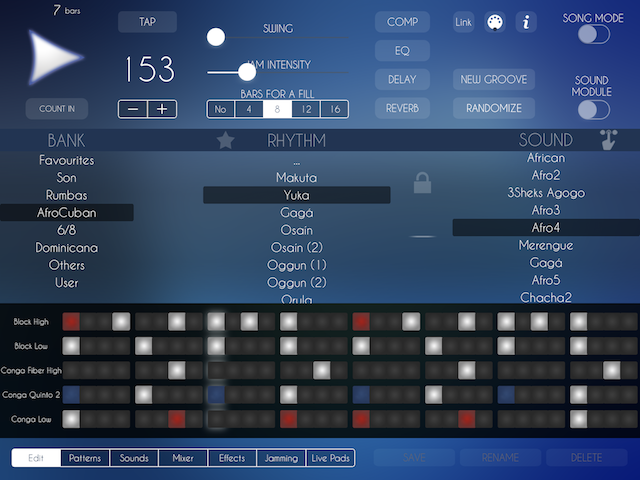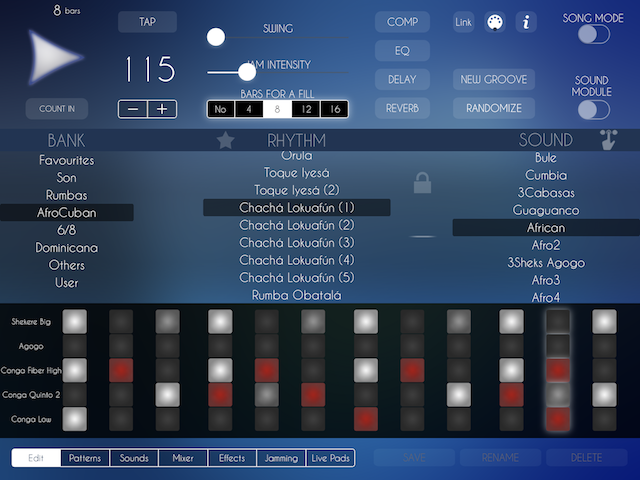Afrocuban Rhythms
Included rhythms in Afro Latin Drum Machine, for iOS
Afro-Cuban Rhythms
Under Spanish control, Cuba became the most profitable sugar region in the world. Sugar was a commodity of enormous value in the 17th and 18th centuries. Individual fortunes and national economies were based on the sugar trade.
Thousands of African slaves were brought in to work on the vast sugar cane plantations. These slaves were controlled by the Spanish in various ways. Among other things, they were forced to speak Spanish and accept Christianity.
In defiance, the balsams gave their African gods the names of Christian saints and continued to work with them in their native languages. This form of work, known as Santeria, preserved many African religious, ritual and musical traditions and is still practiced today.
Santeria is the Oruba religion of Nigeria, which has survived in Cuba. In their ceremonies we can hear West African rhythms in their almost original state. The hourglass-shaped drum beats are used in Santeria to contact the orichas (deities believed to represent and control the forces of nature).
The fusion of African and Spanish influences gave rise to many new musical forms.
Afro-Cuban Rhythms
Makuta
Makuta was played in town halls and recreational societies as entertainment on religious holidays. The technique of the makuta is played by clean hand.
Both the Makuta, the Yuka and the Palo can be found in Matanzas, Havana and some regions of the East.
Yuka
The word Yuka is of Bantu origin and means: to strike or to strike.
The Bantu groups came from the African region of Congo. They are the so-called "paleros" and brought different rhythms and percussion instruments to Afro-Cuban music, such as Catá, Guagua, Nkonko and the Yuka drums.
The Yuka Drums are a set of three wooden drums with thick, sturdy leather patches. From largest to smallest size, Yuka drums are: box, mule and bong.
The dance of the Yuka is danced by a loose couple taking short steps alternating with the toe and the heel, the man chases the woman who tries to avoid it. It is said that their dance is closely related to Cuban rumba.

Gaga
The Gagá comes from Haiti, where its original name is "Rará" which means Haitian Carnival. When the independence revolution began in Haiti in 1791, the French settlers living in this country fled to Cuba and the Dominican Republic, taking with them their slaves who in turn contributed all their instruments and folklore.
In Cuba they settled mainly in the areas of Santiago de Cuba and Guantánamo, although they could also be found in other eastern regions of the island. The Haitian slaves carried the French tomb and since their masters were not so severe with them, they allowed them to play, sing and dance, hence we inherited their entire culture.
Gagá comes from the Voodoo religion and is a dance with erotic dances that take the spectator to a state of pleasure. Their songs in Creole language are diverse and are characterized by being antiphonal and with short verses.
Osain
Osain is an Orisha, a traditional healer who dwells in the forest. All herbs, plants, trees and flowers are his domain.
Oggun
Orisha warrior and guardian. It represents work and human effort. It symbolizes violence, brute force and raw energy.
Orula
Orisha Major. He is the great benefactor of men, their main advisor because he reveals the future to them and allows them to influence it. Orula knows the fate of all living things and beings, how they originated, how they are and how they will end.
Toque Iyesá
Its main use is in festivals and religious rites, since like the Batá drums, it belongs to the Yoruba culture, being catalogued as sacred instruments. Havana and Mantanzas are the two Cuban provinces where it has the greatest presence.
Chachá Lokafún
This profane rhythm is not dedicated to any deity or saint.

Rumba Obatalá
Obatalá is the greatest Orisha of creation. Obatalá is the kind father of all orishas and humanity. Act in the peace and quiet of the home. He is also the master of all minds. Source of all that is pure, wise, gentle and compassionate.